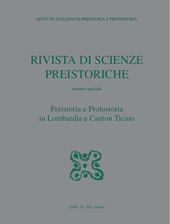I principali insediamenti della cultura di Golasecca : un quadro d'insieme
P. 531-562
Some recent discoveries and the publications of old excavations brought new light on the protohistoric settlements of the Golasecca culture, notably Como, whose origins can be traced back to the Final Bronze Age, as revealed by the small groups of tombs located all around the site. The evidence allows to think that until the end of the 8th century BC small villages existed, with their cemeteries nearby. Starting from the 7th century BC the settlements became differently organized: with a unique exception, no more tombs can be found inside the settled area, but instead are distributed all around it. The 6th century BC represents a time of expansion, during which many dwellings are built and the area is extensively occupied; then the 5th century BC seems to be a renovation period of the settlement, which becomes the main market place for the trades between Etruscans and transalpine Celts.
Analyzing all the available data from the other settlements of the Golasecca culture we can affirm that the 7th century represented the period of the reorganization of almost all the settlements: Bergamo, Castaneda, Castelletto Ticino and Gropello Cairoli. Each one is characterized by a different development, depending on the trade strategies that changed in time. Some new palaeoecological data from recent studies reveal that the site of Bergamo was occupied since the Middle Bronze Age for agricultural and pastoral purposes, while a steady settlement dates back to the Final Bronze Age. Even so the 7th century BC seems a period of a substantial change, due to the decrease of the signals of agricultural activities, that in the Author's opinion were excluded from the village.
Castaneda, on the way to the S. Bernardino pass, survived until the 1st century BC, Gropello Cairoli was an important manufacturing center until the end of the 5th century BC, while Castelletto Ticino, on the river Ticino, after having greatly expanded during the 7th and 6th century BC, suddenly declined without evidence of violent destruction, although some discoveries indicate that the area was not completely abandoned. Thanks to the well-known necropolis of Como and Castelletto Ticino-Sesto Calende-Golasecca we may affirm that these centers certainly evolved to proto-urban sites. It is impossible to say the same for Bergamo, whose cemeteries are still completely unknown; moreover the archeological data of the settlement published until now are uncomplete and sometime incorrectly interpreted.
The catalyst for urbanization was due to the cultural exchanges with the Etruscans, which started in the 8th century BC and became in time tighter, notably in the 7th century BC, until the organized trade of the 5th century BC. The settlements that had longer existence, from the Final Bronze Age to the Roman conquest, were those of Como and Bergamo, where, according to the historical sources, lived the Oromobi tribe. The Leponti tribe, living in the Ct. Tessin, along the Bellinzona Plane and the Meseolcina Valley, had probably their main center near Arbedo and controlled the trade route to the San Bernardino pass with many villages, such as Castaneda and Cama.
The Insubri tribe were likely settled in the Somma Lombardo/Malpensa area during the Final Bronze Age, from which they moved to the site of Castelletto Ticino-Sesto Calende-Golasecca, abandoning again the area at the end of the 6th century BC to settle down in the site of current Milan and giving life to the most important celtic oppidum of the Second Iron Age. Many smaller settlements are known in the Prealpine zone and the Po plane which are still important in economic strategies and trade routes of the Golasecca culture, like Chiuso (LC), which connected Bergamo to Como, Capriate San Gervasio (BG), at the wade on the river Adda, or Miradolo (PV), that controlled the navigation of the river Po, and finally Tremona, which was a stage between Como and the Bellinzona plane.
The occupation of the huge territory of the Golasecca culture changed rapidly after the Gaul invasions in 388 BC. With the exception of the Lepontic territory, many areas were depopulated, the main settlements were reduced in space and importance, and only Milan went under a rapid overwhelming development. [Publisher's text]
Forma parte de
Rivista di scienze preistoriche : LXXII, supplemento, 2022-
Artículos del mismo número (disponibles individualmente)
-
Información
Código DOI: 10.32097/1193
ISSN: 2282-457X


